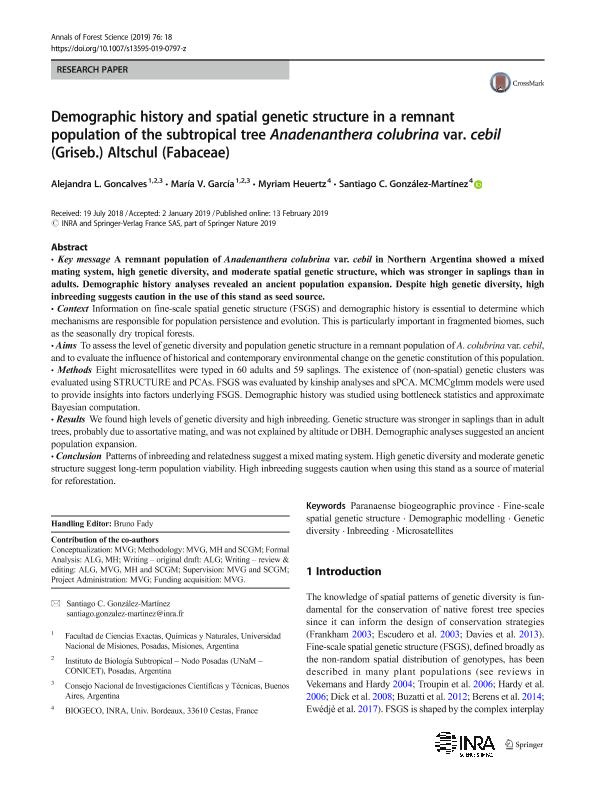Artículo
Demographic history and spatial genetic structure in a remnant population of the subtropical tree Anadenanthera colubrina var. cebil (Griseb.) Altschul (Fabaceae)
Goncalves, Alejandra Lorena ; García, María Victoria
; García, María Victoria ; Heuertz, Myriam; González Martínez, Santiago C.
; Heuertz, Myriam; González Martínez, Santiago C.
 ; García, María Victoria
; García, María Victoria ; Heuertz, Myriam; González Martínez, Santiago C.
; Heuertz, Myriam; González Martínez, Santiago C.
Fecha de publicación:
02/2019
Editorial:
EDP Sciences
Revista:
Annals of Forest Science
ISSN:
1286-4560
e-ISSN:
1297-966X
Idioma:
Inglés
Tipo de recurso:
Artículo publicado
Clasificación temática:
Resumen
A remnant population ofAnadenanthera colubrinavar.cebilin Northern Argentina showed a mixed mating system, high genetic diversity, and moderate spatial genetic structure, which was stronger in saplings than in adults. Demographic history analyses revealed an ancient population expansion. Despite high genetic diversity, high inbreeding suggests caution in the use of this stand as seed source. Context: Information on fine-scale spatial genetic structure (FSGS) and demographic history is essential to determine which mechanisms are responsible for population persistence and evolution. This is particularly important in fragmented biomes, such as the seasonally dry tropical forests. Aims: To assess the level of genetic diversity and population genetic structure in a remnant population of A. colubrina var. cebil, and to evaluate the influence of historical and contemporary environmental change on the genetic constitution of this population. Methods: Eight microsatellites were typed in 60 adults and 59 saplings. The existence of (non-spatial) genetic clusters was evaluated using STRUCTURE and PCAs. FSGS was evaluated by kinship analyses and sPCA. MCMCglmm models were used to provide insights into factors underlying FSGS. Demographic history was studied using bottleneck statistics and approximate Bayesian computation. Results: We found high levels of genetic diversity and high inbreeding. Genetic structure was stronger in saplings than in adult trees, probably due to assortative mating, and was not explained by altitude or DBH. Demographic analyses suggested an ancient population expansion. Conclusion: Patterns of inbreeding and relatedness suggest a mixed mating system. High genetic diversity and moderate genetic structure suggest long-term population viability. High inbreeding suggests caution when using this stand as a source of material for reforestation.
Archivos asociados
Licencia
Identificadores
Colecciones
Articulos(IBS)
Articulos de INSTITUTO DE BIOLOGIA SUBTROPICAL
Articulos de INSTITUTO DE BIOLOGIA SUBTROPICAL
Citación
Goncalves, Alejandra Lorena; García, María Victoria; Heuertz, Myriam; González Martínez, Santiago C.; Demographic history and spatial genetic structure in a remnant population of the subtropical tree Anadenanthera colubrina var. cebil (Griseb.) Altschul (Fabaceae); EDP Sciences; Annals of Forest Science; 76; 1; 2-2019; 1-16
Compartir
Altmétricas



